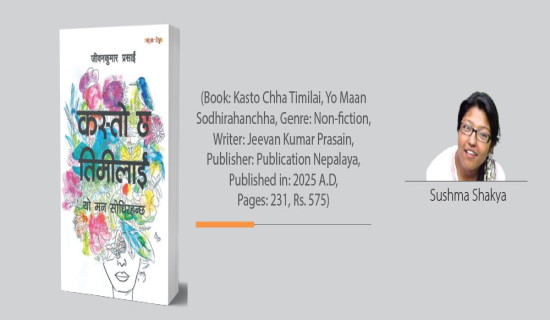- Friday, 16 January 2026
Hazard Of Over-the-counter Antibiotics
Antibiotics, once hailed as miraculous lifesavers, are now confronted with an escalating threat in Nepal, primarily due to a lack of awareness and a weak drug regulatory framework. The pervasive issues of self-medication, inadequate prescription practices, and the uncontrolled use of antibiotics in livestock and agriculture have collectively exacerbated the problem. According to a preliminary report from the study analsing the effect of community education and surveillance of antibiotics use among young children in Nepal, a staggering 65 per cent of cases witnessed the administration of antibiotics without a prescription. This alarming trend underscores the urgent need for increased public awareness, stricter regulations, and a comprehensive approach to address the misuse of antibiotics.
In a study examining the response to antimicrobial resistance in the South-East Asia region, published in the November 2023 issue of The Lancet, it was found that the total consumption of antibacterial drugs in Nepal was 60 defined daily doses (DDD) per 1000 inhabitants per day in 2018, a stark contrast to the mere 14 DDD in central Europe. Additionally, the study revealed that a concerning 70-80 percentage of the most common pathogens in Nepal exhibit resistance to almost all antibiotics. The research further highlighted that 60 percentage of infection-related deaths in Nepal were attributed to antibiotics resistance, and an additional 20 percentage of deaths were directly associated with antibiotic-resistant strains.
Risk of disease spread
Antimicrobial resistance occurs when pathogenic microbes undergo changes over time, rendering them unresponsive to medications. This phenomenon makes infections more challenging to treat, escalating the risk of disease spread, severe illness, and mortality. Consequently, medicines lose their effectiveness, allowing infections to persist and increasing the likelihood of transmission to others. In Nepal, despite antibiotics being prescription drugs, they are easily accessible over the counter. A significant number of individuals acquire them without disclosing their specific health issues to pharmacists.
Additionally, pharmacists frequently overlook inquiring about the nature of the ailment and often fail to emphasise the crucial importance of completing the prescribed medication course. This laxity is recognised as a primary factor contributing to the increasing rates of antimicrobial resistance in Nepal. Another contributing factor lies in the widespread practice of doctors prescribing antibiotics based solely on preliminary clinical diagnosis. It is known that antibiotics prove ineffective against viral infections, underscoring the imperative for a more discerning approach to prescription practices in order to curb the surge of antimicrobial resistance.
On a personal note, during my visit to Nepal last winter, I had to take my two children to a nearby hospital three times due to various health complications. On each occasion, the doctor nonchalantly prescribed antibiotics, whether it was for a trivial thumb wound, a skin allergy, or a suspected case of food poisoning. Engaging in conversation with the pharmacist, I discovered that almost 50 percentage of the daily drug sales in the pharmacy located outside that hospital contributed to the antibiotics prescribed by the doctors. Moreover, a prevalent trend also existed among patients, where there was a significant demand for antibiotics without a doctor's prescription.
A multi-pronged approach is required to address antibiotic misuse, beginning with robust public awareness campaigns. Educating communities about the importance of completing antibiotic courses, the dangers of self-prescribing, and the implications of antibiotic resistance is crucial. Collaborative efforts between healthcare providers, educational institutions, and community organizations can play a pivotal role in disseminating this information. Various reports have shown that educational interventions have proven successful in diminishing the prevalence of antibiotic use without a prescription.
Strengthening regulatory measures is also essential to curb antibiotic misuse. Stricter controls on over-the-counter sales, enhanced monitoring of prescription practices, and penalties for unauthoriSed antibiotic distribution can act as deterrents. Additionally, creating a centralied database to track antibiotic consumption and resistance patterns can aid policymakers in implementing evidence-based interventions. In addition, training healthcare providers on prudent antibiotic prescribing practices is pivotal. Implementing guidelines for diagnosis and treatment, encouraging the use of narrow-spectrum antibiotics, and promoting regular antimicrobial stewardship programs can help align medical practices with global efforts to combat antibiotic resistance.
Antibiotics in livestock
The use of antibiotics in agriculture and livestock also contributes significantly to the emergence of antibiotic-resistant strains. Agricultural antibiotics play a significant role in fostering the emergence of resistant bacteria in meat and poultry products. A study conducted by Nepal Health Research Council (NHRC) revealed that approximately 70 per cent of farmers employed high doses of antibiotics with increased frequency, aiming for a swifter recovery of sick livestock. Implementing regulations on antibiotic use in these sectors, promoting alternative farming practices, and supporting research on sustainable solutions can help strike a balance between agricultural needs and public health.
To conclude, the concerning rise of antibiotic misuse in Nepal demands urgent attention and concerted efforts from various stakeholders. By raising public awareness, strengthening regulatory frameworks, educating healthcare providers, and addressing the broader issues in agriculture and livestock practices, Nepal can take significant strides towards mitigating the threat of antibiotic resistance and safeguarding the effectiveness of these life-saving drugs for future generations.
(The author is an assistant professor of Neurobiology at Martin-Luther University Halle-Wittenberg, Germanpushpa.joshi@gmail.com)
















